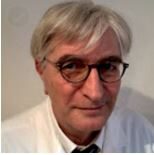Non invasive cardiology involving exercise echocardiography as a non-fancy bedside test should be a corner-stone in diagnosis making and cardiovascular risk assessment. Beside this, we use fancy radiology, that yields more reproducible and more diagnostic results in daily clinical practice.
Fancy radiology is therefore an inevitable requirement for improvements in diagnosis and therapy of many cardiovascular diseases. As 1 out of 4 living cardiologists in Switzerland I can cover CT, CMR and Nuclear, adding stress-echo and carotid imaging approaches probably unique skills in Switzerland.
When I started back in 1994, nuclear was already elaborated, validated and ready for clinical use, while CT and CMR where evolving since 2000 as an important tool in cardiovascular medicine. I have been able to follow the developements since then in daily cardioradiological practice encompassing every year several 100 of patients and multicenter investigations, also together with Prof. Schwitter and Prof. Wahl, from which we received for research purposes patients from the Inselspital, further we performed adenosin stress to scientifically evaluate patency of coronary vessels using coronary connectors, at that time very promising in cardiac surgery.
Actually, I have been reactivting these challenging and rewarding times for about another 5 years. Our tools emcompass first nuclear as usually performed by myself in combination with stress-echo (global function, RF function, pulmonary pressure after exercise, transient ischemic dilation, untriggered volumes rest/stress and lung-heart-ratios for capillary leakage post stress). So this is a real hybrid imaging tool uniquely developed by Kardiolab.
I was a pioneer in Switzerland for Calcium Scoring and coronary angiography with constrast agents, NTG und Betablocker preparation. I am happy to be able to offer, second, this exciting tool for clinical decision making.
Among these techniques, third but not least, CMR remains the most exciting tool, since it allows for tissue characterization and disease quantification in many disease conditions such as coronary artery disease, inflammation and storage problems. The following modules are ready for use: anatomy, LV and RV function, perfusion included adenosin stress, Gadolinium enhancement (early, late), quantitative flow for QpQs, edema imaging with T2 weighted images. These modules allow to reliably test for many conditions such as myocardial infarction (with viability, transmurality), myocarditis, ARVD, DCM, endomyocardial fibrosis, non-compaction, sarcoidosis, tako-tsubo CMP, pericardial disease, pericardial effusion, constrictive pericarditis, valvular heart disease, coronary anomalies, aortic disease, cardiac masses and tumors. Quantification with FDA approved MASS, Netherlands.
Future developements in CMR at our institution ares T1 mapping, T2 mapping, T2* mapping, ECV, free breathing 3D navigator coronary angiography.
If you wish to refer “difficult cases”, please contact me anytime by phone or email (michel.romanens@hin.ch). You may have noticed, that I avoided to mention congential heart disease. Although we did many such studies with CMR in the past, including real time CMR with exercise ergometer CMR imaging for exercise induced regional and global assessment of RV function, complex cases should be referred to centers with high experience in these cases.
